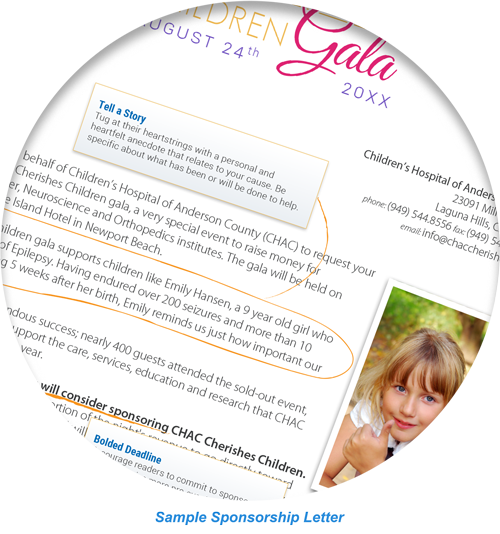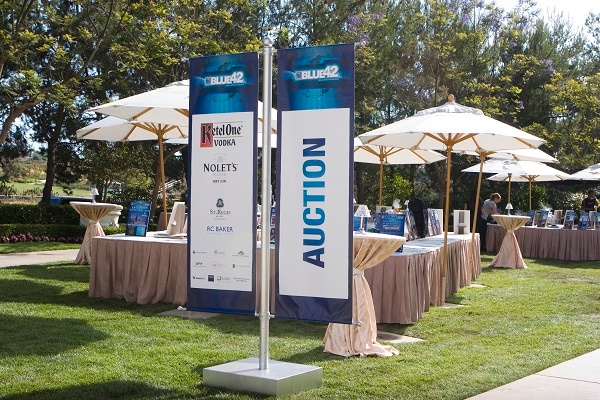
Securing sponsorships is a great opportunity to offset expenses while giving companies the chance to promote their brand at your event.
In a recent post, we looked at the importance of acquiring event sponsors, how to set sponsorship levels, ideas for publicity rewards and tips to find like-minded potential sponsors.
Today we will go over the nuts and bolts of your nonprofit’s most important tool in sponsorship acquisition: the request letter!
Check out 10 easy steps to craft a concise, enthusiastic and effective sponsorship proposal letter.
Best of all, the letter doesn’t need to take a ton of time. To assist, we are proud to unveil our latest free resource: a Sponsorship Kit! Click below to download the Kit with sample letters, forms and easy-to-customize templates that simplify the process from start to finish.
Charity Event Sponsorship Series
This mini-series is meant to guide you through the process of acquiring and retaining sponsorships to support your charity auction fundraising event.
Part 1: The 2-Step Process to Securing Enthusiastic Event Sponsorships
Part 2: 10 Easy Steps to Effective Sponsorship Request Letters
Part 3: Do’s & Don’ts of Charity Event Sponsorship Request Follow Up
Sponsorship Proposal Letters:
Definitely include…
1. Information on your event and organization.
Event: Include the name and date of the event and invite recipients to attend, regardless of whether or not they choose to become a sponsor. Also include key metrics to help them understand the size and scope of your event, such as your fundraising goal, the expected audience size and demographics.
Organization: If your nonprofit doesn’t have one already at hand, prepare a one-page fact sheet, brochure or pamphlet to include with each letter. Consider outlining your history, mission and vision, key statistics, awards or accolades you’ve received and goals for the upcoming year.
{{cta(‘f2a7ad66-bc37-4f6f-ac57-1560c652588b’,’justifycenter’)}}
2. Sponsor opportunities and rewards.
As discussed in the previous post, corporate sponsorship is a form of advertising that elevates and promotes their brand. While it’s important to explain your nonprofit’s mission, keep the focus on how sponsors will benefit. This isn’t simply a donation—your event is a marketing opportunity they can’t afford to pass up.
First, using bullet points, clearly delineate the names and cost of all sponsorship opportunities available. Along with the typical reward tiers, consider including the opportunity to underwrite some costs of your event, like no-risk travel packages in your auction, printing costs for the auction catalog, catering and booking the venue.

Companies are frequently inundated with sponsorship requests, so try and distinguish your event from other fundraisers if possible. For example, point out if there’s a reason a particular company would be a good match for your event (think: a running club sponsoring a 5K).
You can also mention tax benefits from a sponsorship, then direct them to their accountant or CPA with any questions.
{{cta(‘ace6904c-d5a9-4f23-afcc-36e09cf0f71e’,’justifycenter’)}}
3. A personalized salutation.
Think of your letter as a time-saving substitute for the ideal face-to-face sponsorship ask. You’ll want to recreate as personal of a feeling in the letter as you can.

While researching, try to find out whether or not the organization has a charitable giving policy which you can reference in your letter.
4. Your event and organization logos.
Print each letter on nice letterhead to make your organization look credible. Similarly, design and include an event logo, making the event appear polished and professional. This mailing is their first impression of not only your nonprofit but the kind of graphic design style and quality they can expect from your marketing materials, so sophistication is key.
5. A specific, bolded ask.
Establish as soon as possible the point of your correspondence (“We would like to invite Your Company to become a sponsor for this year’s event.”) Bold and/or underline one clear call-to-action.
6. The deadline for sponsorship submission.
Remind potential sponsors that the earlier they submit, the more media impressions they will receive from your social media and website. The deadline is especially important for time-sensitive rewards like print advertising and TV spots.
7. How to submit a sponsorship.
Local companies and small businessowners are extremely busy people. Make it as easy as possible to sponsor your event. Include contact information (phone and email) at both your return address on top and signature on bottom, plus methods of payment (e.g. via enclosed check or credit card).
Try to include…
8. A personal story or anecdote
If you have space in your letter, tug at the reader’s heartstrings with a quick, heartfelt anecdote related to your cause. Tell a story of one person whose life has been changed by your programs, or how the community is better because of the funds raised from last year’s event.
9. A picture
This story will pack even more of a punch when accompanied by a related picture, which gives your organization credibility and dimension.
10. A self-addressed, stamped envelope
Every additional step the potential sponsor must take to submit their registration is another point at which they might get distracted, change their mind or forget. Including an envelope makes the registration process that much smoother—and the cost of any one stamp could turn into thousands of dollars in sponsorships!
General Tips
Keep your letter to one page, then include additional inserts as needed for details on your organization and/or publicity rewards. Concentrate the one-page letter on the exposure the company will receive, not how the donation will help you.
- Structure the letter in standard business letter format.
- Upload sponsorship opportunities online so you can easily link to them in emails and on the website.
- Personalize our templates in the Sponsorship Kit!
As you can see, there are many different moving parts to writing simple but effective sponsorship letters. Thankfully the process is a breeze with the help of our Sponsorship Kit. As promised, here’s a link to request your free copy.
Fill out the form and immediately get access to 100%-customizable request letter templates, 3 versions of a sponsorship form (sponsors can either write in or select their desired sponsorship level), an example sponsorship letter and sample reward tiers, plus a thank you letter template. Click below to get the Sponsorship Kit today.
{{cta(’16c8f909-9068-47c6-b768-aee863bfc827′,’justifycenter’)}}
The final pieces of the sponsorship process: tracking sponsors, following up with proposals and ensuring a positive experience that keeps supporters returning year after year. Stay tuned to Winspire News for more in an upcoming post. (If you haven’t already, subscribe today and never miss a post.)
{{cta(‘91403318-3ab0-4603-a312-9e2a6613faac’,’justifycenter’)}}


 Keep your letter to one page, then include additional inserts as needed for details on your organization and/or publicity rewards. Concentrate the one-page letter on the exposure the company will receive, not how the donation will help you.
Keep your letter to one page, then include additional inserts as needed for details on your organization and/or publicity rewards. Concentrate the one-page letter on the exposure the company will receive, not how the donation will help you.